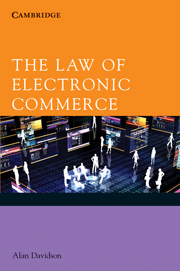Book contents
- Frontmatter
- Contents
- Acknowledgements
- Table of Cases
- Table of statutes
- 1 The law of electronic commerce
- 2 The rule of cyberspace
- 3 Electronic commerce and the law of contract
- 4 Shrinkwrap, clickwrap and browsewrap contracts
- 5 Electronic signatures
- 6 Copyright issues in electronic commerce
- 7 Electronic commerce – trade marks, patents and circuit layouts
- 8 Domain names
- 9 Domain name disputes
- 10 Uniform domain name dispute resolution policies
- 11 Jurisdiction in cyberspace
- 12 Defamation in cyberspace
- 13 Privacy and data protection in cyberspace
- 14 Electronic mail and online presence
- 15 National electronic surveillance
- 16 Cybercrime
- 17 Evidence of electronic records
- 18 Censorship – Broadcast and online content regulation
- 19 An international perspective
- Appendix A Electronic Transactions (Victoria) Act 2000
- Appendix B UNCITRAL Model Law on Electronic Commerce
- Appendix C Selected provisions Copyright Act 1968 (Cth)
- Appendix D ICANN Uniform Dispute Resolution Policy (UDRP)
- Appendix E .au Dispute Resolution Policy (auDRP)
- Appendix F National Privacy Principles
- Index
- References
7 - Electronic commerce – trade marks, patents and circuit layouts
Published online by Cambridge University Press: 05 June 2012
- Frontmatter
- Contents
- Acknowledgements
- Table of Cases
- Table of statutes
- 1 The law of electronic commerce
- 2 The rule of cyberspace
- 3 Electronic commerce and the law of contract
- 4 Shrinkwrap, clickwrap and browsewrap contracts
- 5 Electronic signatures
- 6 Copyright issues in electronic commerce
- 7 Electronic commerce – trade marks, patents and circuit layouts
- 8 Domain names
- 9 Domain name disputes
- 10 Uniform domain name dispute resolution policies
- 11 Jurisdiction in cyberspace
- 12 Defamation in cyberspace
- 13 Privacy and data protection in cyberspace
- 14 Electronic mail and online presence
- 15 National electronic surveillance
- 16 Cybercrime
- 17 Evidence of electronic records
- 18 Censorship – Broadcast and online content regulation
- 19 An international perspective
- Appendix A Electronic Transactions (Victoria) Act 2000
- Appendix B UNCITRAL Model Law on Electronic Commerce
- Appendix C Selected provisions Copyright Act 1968 (Cth)
- Appendix D ICANN Uniform Dispute Resolution Policy (UDRP)
- Appendix E .au Dispute Resolution Policy (auDRP)
- Appendix F National Privacy Principles
- Index
- References
Summary
The digital revolution has necessitated a re-examination of intellectual property issues by intellectual property holders, users and law makers. The nature of the digital age enables data to be easily copied, published and disseminated. Placing data, images, logos and text, for example, on internet websites, is child's play. This means that trade mark holders have a new frontier to battle. Misuse of their trade mark rights, deliberate or incidental, commercial or personal, arises in relation to cybersquatting and domain names, hyperlinking (particularly deep linking), framing in web pages and the use of meta-tags.
This chapter addresses issues relating to the impact of electronic commerce on the specific intellectual property rights of trade marks, patents and circuit layouts. It is intended to be only a brief overview of the law in these areas. The chapter will discuss the use and design of the internet, including hyperlinks, framing and meta-tags. Patents involving software and hardware are considered, and the specific intellectual property type known as circuit layouts is described. Cybersquatting and related issues are discussed in Chapters 8 and 9.
The nature of trade marks
A trade mark is ‘a sign used, or intended to be used, to distinguish goods or services dealt with or provided in the course of trade by a person from goods or services so dealt with or provided by any other person’. A trade mark is used in the course of trade to show a connection between a particular business and the goods or services it supplies.
- Type
- Chapter
- Information
- The Law of Electronic Commerce , pp. 110 - 125Publisher: Cambridge University PressPrint publication year: 2009



